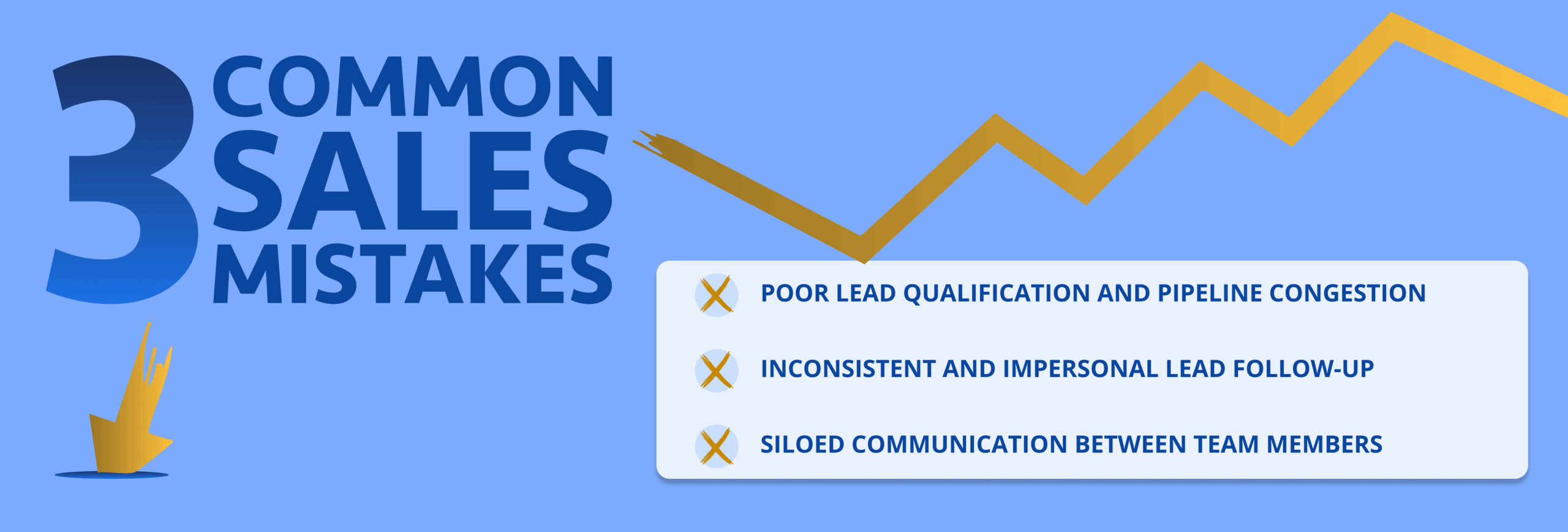3 B2B Sales Process Mistakes to Avoid: How to Improve Your Sales Performance at Every Stage


Stuart Bontrager
The B2B sales process is a multi-step framework to sell products or services to other businesses. Unlike B2C sales, it typically involves longer sales cycles, multiple decision-makers, and is about managing complex deals with clarity and consistency.
But even the most experienced B2B sales professionals can underperform if they overlook the fundamentals. In this post, we break down three of the most common b2b selling process mistakes and show you how to avoid them before they erode your pipeline performance.
The Essential Guide to Sales Pipeline Management
Learn our strategic approach to tracking prospects throughout the pipeline, forecasting revenue, and closing more deals.
What are the stages of the B2B sales process?
The B2B sales process typically has six to eight distinct stages, depending on factors like deal size and the complexity of the solution being sold. For clarity and focus, we are outlining six core stages that represent the essential structure of a successful B2B sales journey.
- Prospecting and lead qualification – Identify and attract potential business clients to determine if they fit your Ideal Customer Profile (ICP).
- Discovery and research – Communicate and ask questions to understand the prospect’s pain points, business goals, and decision-making process.
- Solution demonstration – Tailor a demo to illustrate your solution’s key benefits, highlighting ROI and how it will solve their problems.
- Objection handling – Address concerns, such as pricing, timing, competitors, or internal buy-in, to reinforce your value proposition and build trust.
- Negotiation and closing – Finalize terms, pricing, and contract details while guiding the prospect toward a clear, confident yes to your proposal.
- Handoff and onboarding – Ensure a smooth handoff to implementation or account management, setting the tone for long-term satisfaction and retention.
With so many stages of a sale to consider, there are ample opportunities to make mistakes that can derail the deal. Even small missteps can have a ripple effect across the entire sales process. Recognizing where things tend to go wrong is the first step toward building a more efficient, high-performing B2B sales process.

Mistake #1: Poor lead qualification and pipeline congestion
One of the most common issues in B2B sales is wasting valuable time on unqualified leads. This often stems from the absence of a clearly defined lead qualification process. Without defined processes and proper training techniques that set your team up to use them, your deal funnel gets clogged with leads that were never a good fit to begin with, lowering win rates and distracting focus from high-value opportunities.

The Fix: Consistency in sales training techniques
Implementing consistent sales training techniques is essential to delivering better results. Train your team to use proven opportunity qualification frameworks such as BANT (Budget, Authority, Need, Timing) or MEDDIC. Additionally, regular pipeline reviews focused on key metrics like lead-to-opportunity conversion rates ensure the team stays aligned and the funnel remains flowing.

Mistake #2: Inconsistent and impersonal lead follow-up
Failing to follow up consistently or relying on generic, impersonal messages can quickly turn warm leads cold. Without a structured follow-up cadence and personalized outreach, prospects may feel undervalued and eventually lose interest. This inconsistency not only reduces engagement but also creates missed opportunities to demonstrate your solution’s value and, ultimately, deteriorates trust.

The Fix: Effective follow-up processes
Establishing a consistent follow-up rhythm combined with personalized messaging is key to nurturing leads effectively. Use CRM tools to track interactions and set reminders, ensuring timely outreach. Incorporate tailored communications that address each prospect’s unique pain points and stage in the buying journey. Regular coaching and review of follow-up metrics help maintain accountability and improve engagement rates across the board.

Mistake #3: Siloed communication between team members
When sales, marketing, and customer support teams operate in isolation, critical information about leads and customers can be miscommunicated. A siloed structure creates gaps in the sales process and causes duplication of effort or overlooked handoffs. Without cross-team collaboration, it’s harder to align messaging and strategy, which can slow the sales cycle and decrease customer satisfaction, leading to missed opportunities.

The Fix: Foster cross-team collaboration and information sharing
All teams involved in the customer lifecycle should regularly communicate and collaborate. To facilitate this, utilize shared tools like project management software to centralize data and updates. Schedule regular, cross-team collaboration meetings to align goals, share insights, and address challenges. Building a culture of transparency and teamwork ensures everyone is working toward the same objectives and, most importantly, delivers a seamless buyer experience.
The Essential Guide to Sales Pipeline Management
Learn our strategic approach to tracking prospects throughout the pipeline, forecasting revenue, and closing more deals.
Get the best in B2B sales techniques with EBQ
To recap, three of the most common B2B sales process mistakes include

Poor lead qualification wastes valuable time

Inconsistent follow-up lets warm leads slip away

Siloed communication disrupts both internal alignment and the customer experience.
These are regular pitfalls — even for seasoned sales teams — but they are also completely avoidable. With the right support in place, you can stay focused on the bottom line instead of troubleshooting gaps in the sales process.
At EBQ, our dedicated B2B sales team integrates seamlessly with your organization to implement proven strategies that help you close more deals and drive long-term business growth. When you work with EBQ, you’re assigned a dedicated rep who takes the time to learn the ins and outs of your brand, messaging, and processes. They function as an extension of your team, not just an outside partner, ensuring every interaction aligns with your goals and voice.
About the Author:
Stuart is one of EBQ’s Revenue Consultants with over 20 years of experience in Sales. His tenure as the VP of Sales sharpened his expertise in translating business visions into lead-generation tactics.
